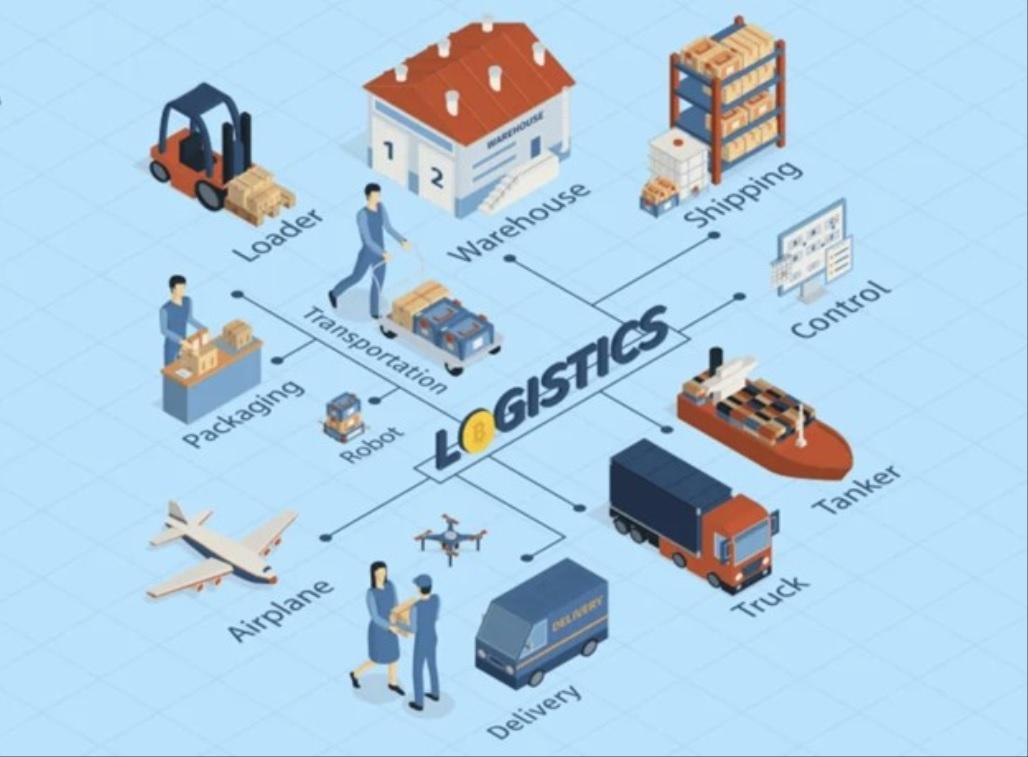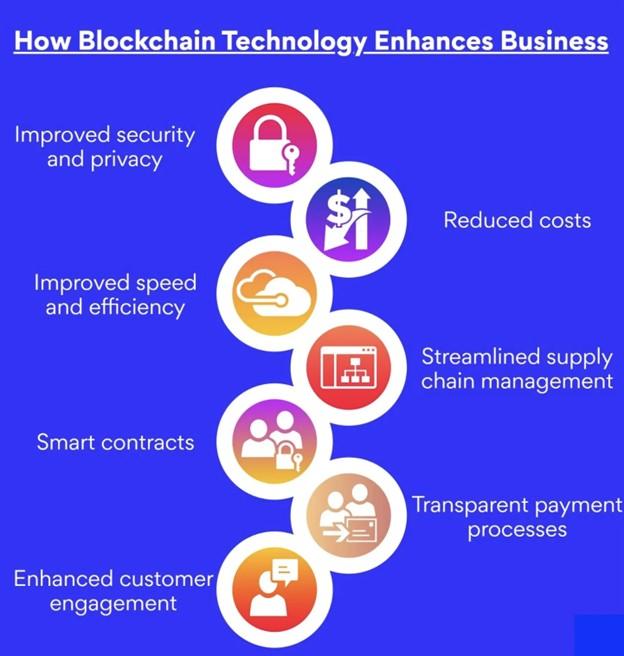The Eminent Role and Use Cases of Blockchain in Logistics
The modern digital era continuously throws buzzwords into the limelight, but not all stand the test of time and practical application. Among them, Blockchain has emerged not merely as a fleeting trend but as a groundbreaking technology. It’s reshaping industries, with its promise of transparency, security, and decentralization. Often linked with cryptocurrencies, Blockchain’s potential reaches much farther than digital wallets. Today, as industries are looking for novel ways to perform feats of efficiency and outbeat competitors, the relevance of Blockchain in logistics and supply chain has surged. This piece aims to present the salient advantages of the technology by explaining its principles of work, furnishing a market overview, and even mentioning possible pitfalls. Eager to adopt the prominent trend for yourself? Then read on!
Blockchain technology in logistics: a market overview
The blend of Blockchain’s decentralized and secure nature with the intricate and multi-layered world of logistics is a burgeoning nexus that the market has keenly observed.
The initial interest in leveraging Blockchain technology in logistics and supply chain management was spurred by the tech’s success in finance, particularly with cryptocurrencies. The appeal of a decentralized and transparent ledger system capable of providing real-time updates resonated with eminent logistics experts. They recognized the potential to address inefficiencies like delays due to paperwork, lack of transparency in shipment tracking, and discrepancies in transactions.
Today, the industry’s powerhouses like DHL and Maersk are demonstrating Blockchain logistics use cases that highlight the innovation’s potential to transform supply chain security and traceability.
According to the insights provided by this research, the market is projected to expand with a compound annual growth rate of 39.78%, amounting to an impressive increase of USD 2,230.89 million between 2023 and 2027.
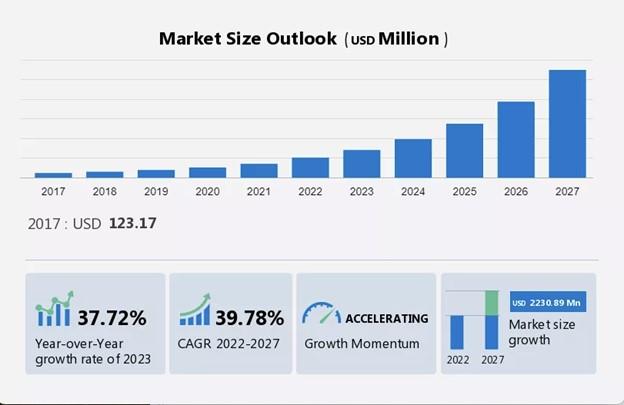 Among the foremost tech creators offering top-notch Blockchain software development services, we can list Accenture, Amazon, Deloitte, and Oracle, to name a few, as well as some smaller-sized but not less ambitious and accomplished companies like Andersen.
Among the foremost tech creators offering top-notch Blockchain software development services, we can list Accenture, Amazon, Deloitte, and Oracle, to name a few, as well as some smaller-sized but not less ambitious and accomplished companies like Andersen.
Blockchain is making strides in various facets of logistics. In particular, it has found applicability within the following domains:
- Shipment tracking;
- Compliance and verification;
- Inventory management;
- Secure payment systems;
- Temperature-sensitive shipments;
- Return and authenticity verification;
- Supplier and stakeholder authentication.

As the domain continues to intertwine with technology, the application areas for Blockchain within this sector are poised to grow.
Read more: Transforming the Inefficiencies in Logistic Sector with Blockchain
Grasping the basics: how Blockchain in logistics actually works
At its essence, the innovation functions as a distributed digital record book. Instead of a centralized database managed by a single organization, this mechanism disperses its information over numerous systems. Every action is documented on a ‘segment’ and linked in order to the one before it.
Within the realm of logistics, imagine an action as goods transitioning from Location X to Location Y. When such an action begins, it’s disseminated to a collection of terminals (systems) for confirmation. After authentication, grounded on encryption techniques, it integrates into the Blockchain. This not only vouches for the data’s legitimacy but also ensures its resistance to unauthorized changes.
Moreover, the information stands unalterable. Once a segment (or action) is incorporated, modifying it demands agreement from most of the vast network. This curbs numerous potential deceptive paths, guaranteeing authentic and clear logs throughout the transport phase.
Harnessing intelligent agreements—self-activating deals where stipulations between a purchaser and merchant are directly inscribed in digital language—marks another phase in the merger of Blockchain and logistics. In practice, this translates to immediate settlements post-delivery or fines if set terms falter, all orchestrated sans manual oversight.
 Unlocking the opportunities of Blockchain-driven logistics
Unlocking the opportunities of Blockchain-driven logistics
So why has the phenomenon of Blockchain in logistics become highly salient in the sector, and why the increasing number of powerhouses choose it as the bedrock for their software?
Reason #1: Improved traceability
For goods traveling across international borders, through multiple carrier services and checkpoints, dedicated software provides an unparalleled level of traceability. Every handover, every inspection, and every payment can be recorded. This ensures that stakeholders at any point can trace the journey of an item, right back to its origin, fostering a transparent and trust-filled environment.
Moreover, for goods that require specific environmental conditions, such as pharmaceuticals or perishables, the software can record and verify if these conditions were maintained throughout transit. This assures recipients of the essential product’s integrity.
Reason #2: Enhanced transparency
At the heart of the decentralized genius lies the open ledger system. Unlike concealed databases or clandestine records of the past, this unalterable ledger unfurls every transaction for all to witness. From the initiation of a product’s journey to the provision of delivery services, each step is documented and has its part in an unbroken chain of events, creating an open narrative for every stakeholder involved.
As actions occur, they’re instantly reflected across the network. Be it a product crossing international borders or a change in its storage conditions, stakeholders can access real-time information, maintaining an ever-aware stance.
Reason #3: Reduced fraud
As we mentioned earlier, one of tech’s salient features is its ability to create records that, once established, can’t be altered covertly. Each transaction is, figuratively speaking, etched into the digital stone, offering a transparent chronicle of every item’s journey. This unyielding permanence acts as a deterrent against any alterations with malicious intent, ensuring a product’s history remains unadulterated.
The Blockchain technology in logistics doesn’t act as a solo guardian. It operates within a network, where transactions are verified by sundry nodes before gaining approval. This approach, akin to a collective vigil, ensures that deceptive activities are spotted and thwarted long before they embed themselves within the system.
Touching on counterfeit goods and false product narratives, clear record-keeping highlights the true origin and journey of every item. From the cotton field to the apparel store, or the orchard to the fruit basket, every step is logged, ensuring consumers and businesses alike can trace an item’s genuine provenance.
In continuation to the above, the software helps verify the authenticity of returned goods and services, ensuring they are the ones that were originally sent out. Furthermore, it can be employed to authenticate suppliers and other stakeholders, ensuring that only verified entities are part of the supply chain.
Finally, during the development of digital contracts that we outlined earlier in this piece, they can be programmed to trigger payments, shipments, and other contractual obligations. This, logically, reduces the chances of deceitful breaches or awkward misrepresentations.
Reason #4: Faster settlements
Rather than wading through layers of bureaucracy or waiting on central entities, next-gen services operate on a decentralized consensus mechanism. This means that every transaction is swiftly verified by a myriad of nodes in the network. Rapid-fire validation ensures that settlements, which once lagged, now zip through with alacrity.
To illustrate, goods passing through international borders now have their documentation instantly verified, thereby expediting the shipping process.
Once again, the proverbial smart contracts automate, and thus, accelerate transactions. Imagine a shipment that, upon reaching its destination, instantly triggers a payment without any human intervention. This digitized efficiency drastically trims down delays.
Reason #5: Lower costs
So, how exactly does the technology combat the financial implications of the logistics industry?
Traditional logistics is often riddled with a maze of middlemen—brokers, agents, and other intermediaries—all of whom require their share of the pie. A decentralized and transparent ledger system paves the way for direct, peer-to-peer interactions. By eliminating or reducing the need for intermediaries, organizations can retain a larger slice of the revenue, translating to palpable cost savings.
Trust is a pricey commodity in logistics. Ensuring that parties are genuine, products are authentic, and terms are adhered to often incurs additional costs. Immutable records minimize the need for external verification processes. The introduction of digital contracts further automates trust, triggering actions only when agreed-upon conditions are met, reducing administrative overheads.
By providing real-time access to data and streamlining communication across the supply chain, the time spent on reconciling disparate records or tracking down shipment details is reduced. Quicker processes mean fewer man-hours spent on administrative tasks, allowing for cost redistribution to more value-adding activities.
In a traditional setting, manual entries and multi-party handling can lead to errors, sometimes costly ones. Additionally, the risk of fraud, be it through counterfeit products or falsified records, sadly results in significant financial losses. The innovation’s transparent and unchangeable nature dramatically reduces these risks, ensuring that errors and fraud are minimized, if not eradicated.
Lastly, the comprehensive data capture ability can be harnessed for analytical insights. By understanding patterns, predicting demands, and optimizing routes, organizations then make farsighted strategic decisions. Better planning, in turn, translates to reduced wastages, optimized inventory levels, and cost-efficient resource allocation.
Reason #6: Increased security
Traditional systems, often centralized, present a singular point of vulnerability. In contrast, the cutting-edge tech disperses its data across a multitude of nodes. Decentralization means that any malicious attempt to alter data must overpower a majority of the network—a Herculean task, making breaches nigh impossible.
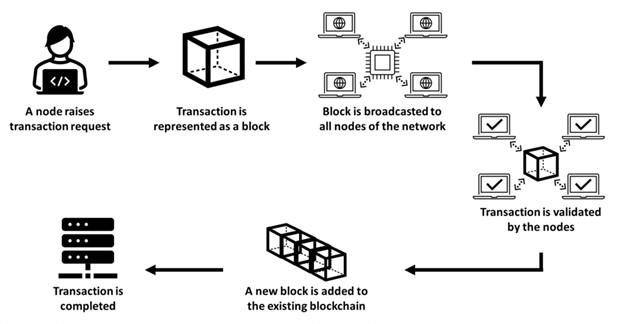 Additionally, every byte of information within the chain is enveloped in layers of cryptographic algorithms. This isn’t just any encryption; it’s a fortress of codes, ensuring that data—whether it’s a shipment’s details or a monetary transaction—remains accessible only to those with the right cryptographic keys. By utilizing this cryptographic security, payments between parties (be it B2B or B2C) become increasingly streamlined and secured.
Additionally, every byte of information within the chain is enveloped in layers of cryptographic algorithms. This isn’t just any encryption; it’s a fortress of codes, ensuring that data—whether it’s a shipment’s details or a monetary transaction—remains accessible only to those with the right cryptographic keys. By utilizing this cryptographic security, payments between parties (be it B2B or B2C) become increasingly streamlined and secured.
Reason #7: Global сonnectivity
In an age where collaborations define success, Blockchain is becoming the cornerstone of global partnerships. Joint ventures, cooperative projects, or shared supply chain efforts can all be managed in one place, ensuring that every participant, irrespective of their geographical location, stays updated and aligned with the project’s goals.
Historically, crossing international borders with goods was a dance of paperwork, varying regulations, and time-consuming checks. By storing customs documentation, compliance proofs, and product details in a universally accessible and immutable ledger, cross-border trade can become swifter, with automated verifications expediting clearance processes.
Amidst the multitude of languages, cultures, and practices in global trade, state-of-the-art technology provides a singular, coherent language. A decentralized ledger offers a standardized format, making data interpretation consistent whether you’re in Bangkok, Boston, or Buenos Aires. This commonality fosters clearer communication, reducing misunderstandings and facilitating quicker decision-making.
As products journey across oceans and landscapes, stakeholders from various parts of the world can track the movement in real time. The technology offers immediate updates on stock levels and product statuses, ensuring inventory data remains consistent across systems. Thus, manufacturers, say, in Europe know exactly when their goods reach a warehouse in Asia, and a retailer in Africa is in the right position to prepare for an incoming shipment from North America without delay. This instantaneous connectivity ensures that the entire supply chain operates in harmony.
Read more:Benefits Of Blockchain In Supply Chain Security And How Will Change The Future Of Supply Chain
Overcoming challenges in the interplay of Blockchain and logistics
Like any promising frontier, the interweaving of Blockchain and logistics isn’t devoid of hurdles. Recognizing and navigating these challenges is paramount to successfully embedding the tech’s advancements within the industry’s tapestry.
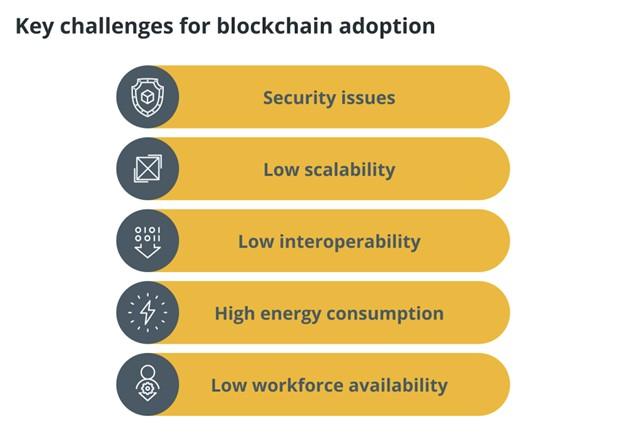 To begin with, a pivotal concern in logistics is the coexistence of multiple, often outdated, IT systems across different stakeholders. Seamlessly integrating a newly created one requires an alignment of miscellaneous infrastructures to communicate with a universal digital ledger. Solutions lie in the development of interoperable platforms and standardization of data entry protocols to ensure cohesion.
To begin with, a pivotal concern in logistics is the coexistence of multiple, often outdated, IT systems across different stakeholders. Seamlessly integrating a newly created one requires an alignment of miscellaneous infrastructures to communicate with a universal digital ledger. Solutions lie in the development of interoperable platforms and standardization of data entry protocols to ensure cohesion.
Furthermore, the decentralized nature of platforms demands collective participation. Gaining the trust and collaboration of all players, from manufacturers to end-delivery agents, is crucial. Regular training sessions, demonstrations of benefits, and collaborative pilot projects all have good chances to foster an environment of understanding and shared vision.
While platform prototypes might function flawlessly in controlled environments, scaling them to cater to the vast expanse of global logistics is a different ball game. Development engineers are constantly innovating, optimizing algorithms, and exploring layer-2 solutions to ensure that networks remain agile and responsive as they expand.
Given Blockchain’s relatively novel status, legal frameworks in many regions are still catching up. It’s essential to be proactive, working alongside policymakers to craft regulations that support innovation while ensuring compliance and public interest.
The broader ecosystem, including interfaces and third-party integrations, must also be fortified just like the platform itself. Regular security audits, embracing best practices in cybersecurity, and ensuring redundancy will mitigate potential vulnerabilities.
Last but not least, initial setup and migration to the Blockchain can be capital-intensive. However, stakeholders must be made to see beyond the immediate costs. The long-term efficiencies, transparency gains, and potential revenue upticks will, in many cases, justify the initial investment.
To sum up, charting the course of Blockchain in logistics isn’t a mere technological upgrade; it’s a paradigm shift in development and operation. Addressing challenges head-on, with a mix of innovation, collaboration, and foresight, will pave the way for a logistics sector that’s more transparent, efficient, and robust.
This article has been contributed and written by Valentin Kuzmenko, VP of Sales at Andersen
Stay informed with daily updates from Blockchain Magazine on Google News. Click here to follow us and mark as favorite: [Blockchain Magazine on Google News].
Get Blockchain Insights In Inbox
Stay ahead of the curve with expert analysis and market updates.
latest from tech
Disclaimer: Any post shared by a third-party agency are sponsored and Blockchain Magazine has no views on any such posts. The views and opinions expressed in this post are those of the clients and do not necessarily reflect the official policy or position of Blockchain Magazine. The information provided in this post is for informational purposes only and should not be considered as financial, investment, or professional advice. Blockchain Magazine does not endorse or promote any specific products, services, or companies mentioned in this posts. Readers are encouraged to conduct their own research and consult with a qualified professional before making any financial decisions. The featured image used is just a creative depiction of the title and it does not intend to hurt sentiments of any person or institution. If it hurts anyone sentiments, please do not hesitate to reach out to Blockchain Magazine.

 Bitcoin
Bitcoin  Ethereum
Ethereum  XRP
XRP  Tether
Tether  Solana
Solana  USDC
USDC  Dogecoin
Dogecoin  Cardano
Cardano  Lido Staked Ether
Lido Staked Ether  TRON
TRON  Chainlink
Chainlink  Wrapped Bitcoin
Wrapped Bitcoin  Sui
Sui  Wrapped stETH
Wrapped stETH  Avalanche
Avalanche  Stellar
Stellar  Hedera
Hedera  Toncoin
Toncoin  Shiba Inu
Shiba Inu  LEO Token
LEO Token  Hyperliquid
Hyperliquid  Bitget Token
Bitget Token  Litecoin
Litecoin  WETH
WETH  USDS
USDS  Polkadot
Polkadot  Bitcoin Cash
Bitcoin Cash  Ethena USDe
Ethena USDe  MANTRA
MANTRA  Wrapped eETH
Wrapped eETH  Uniswap
Uniswap  Ondo
Ondo  Pepe
Pepe  Aave
Aave  Monero
Monero  NEAR Protocol
NEAR Protocol  WhiteBIT Coin
WhiteBIT Coin  Mantle
Mantle  Dai
Dai  Aptos
Aptos  Official Trump
Official Trump  Internet Computer
Internet Computer  Ethereum Classic
Ethereum Classic  Bittensor
Bittensor  Cronos
Cronos  OKB
OKB  POL (ex-MATIC)
POL (ex-MATIC)  Gate
Gate 